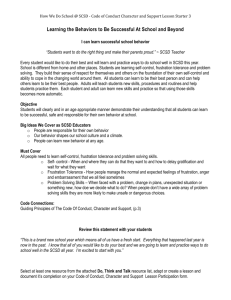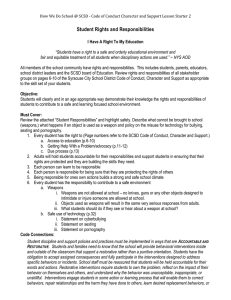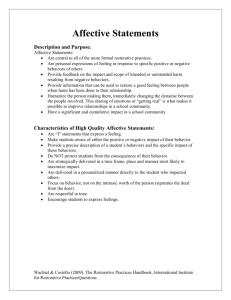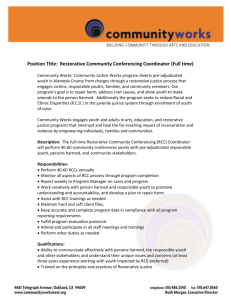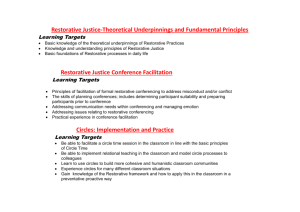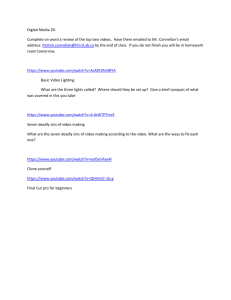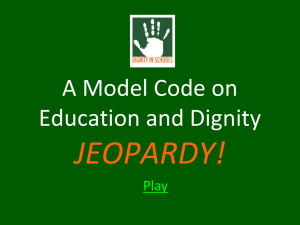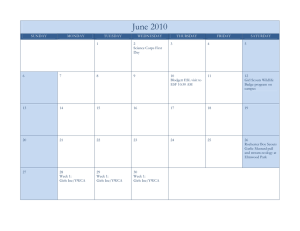Code Lesson Starter 4: Restorative Practices and Restitition
advertisement
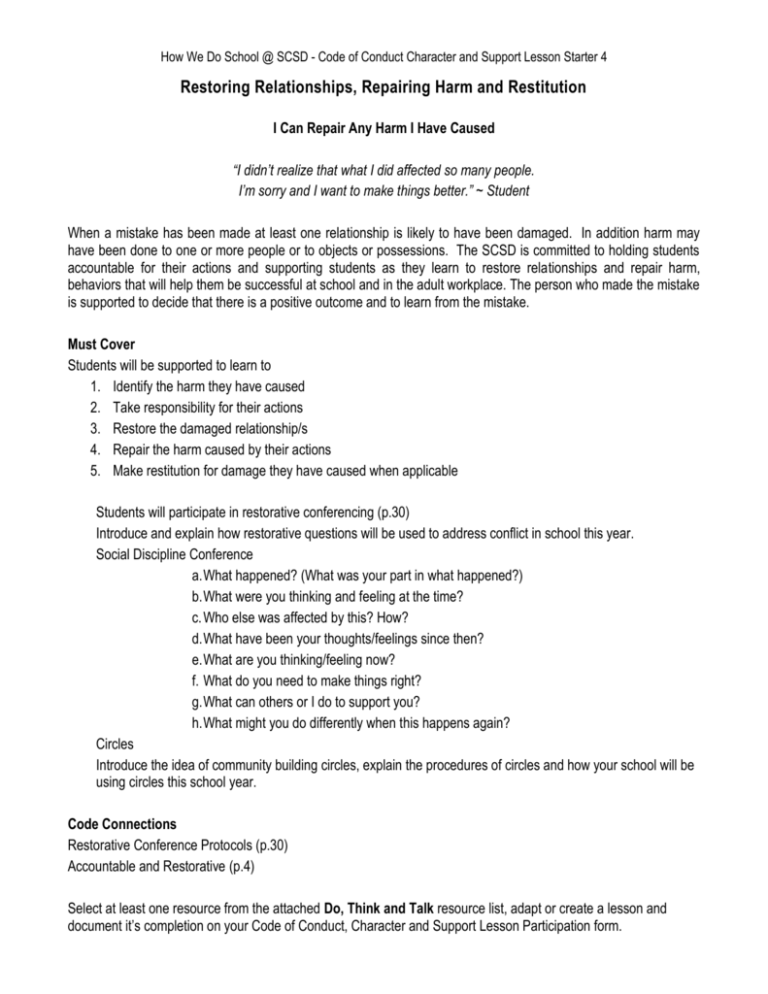
How We Do School @ SCSD - Code of Conduct Character and Support Lesson Starter 4 Restoring Relationships, Repairing Harm and Restitution I Can Repair Any Harm I Have Caused “I didn’t realize that what I did affected so many people. I’m sorry and I want to make things better.” ~ Student When a mistake has been made at least one relationship is likely to have been damaged. In addition harm may have been done to one or more people or to objects or possessions. The SCSD is committed to holding students accountable for their actions and supporting students as they learn to restore relationships and repair harm, behaviors that will help them be successful at school and in the adult workplace. The person who made the mistake is supported to decide that there is a positive outcome and to learn from the mistake. Must Cover Students will be supported to learn to 1. Identify the harm they have caused 2. Take responsibility for their actions 3. Restore the damaged relationship/s 4. Repair the harm caused by their actions 5. Make restitution for damage they have caused when applicable Students will participate in restorative conferencing (p.30) Introduce and explain how restorative questions will be used to address conflict in school this year. Social Discipline Conference a. What happened? (What was your part in what happened?) b. What were you thinking and feeling at the time? c. Who else was affected by this? How? d. What have been your thoughts/feelings since then? e. What are you thinking/feeling now? f. What do you need to make things right? g. What can others or I do to support you? h. What might you do differently when this happens again? Circles Introduce the idea of community building circles, explain the procedures of circles and how your school will be using circles this school year. Code Connections Restorative Conference Protocols (p.30) Accountable and Restorative (p.4) Select at least one resource from the attached Do, Think and Talk resource list, adapt or create a lesson and document it’s completion on your Code of Conduct, Character and Support Lesson Participation form. How We Do School @ SCSD - Code of Conduct Character and Support Lesson Starter 4 Do, Think and Talk ~ Questions and Conversation Starting Activities Pre K-2 Grade 3-5 6-8 9-10 11-12 Activity: Conversation Starter Questions and Quotes “I didn’t realize that what I did affected so many people. I’m sorry and I want to make things better.” ~ Youth PreCharge Client “There are different kinds of Justice. Retribution justice is largely Western. The African undertaking as far more restorative – not so much to punish as to redress or restore a balance that has been knocked over.” Desmond Tutu Video: Classroom Circles/Daily Rap https://vimeo.com/32384751 Video: Conflict https://www.youtube.com/w atch?v=Gl3e-OUnavQ Lesson: Justice Circle http://www.cred ucation.org/reso urces/RJ_Lesso n_3_Justice_Cir cle_Part_1.pdf Video: Replacing suspension with talking circles https://www.youtube.com/watch?v=g8_94O4ExSA Video: Introducing Restorative Justice for Oakland Youth https://www.youtube.com/watch?v=ZtdoWo1D3sY Video: Community Building Circles https://www.youtube.com/watch?v=RdKhcQrLD1w Video: Welcome and Re-Entry Circle https://www.youtube.com/watch?v=uSJ2GPiptvc Literature: Essay –Personal Responsibility 102 http://www.artofmanliness.com/2013/02/19/how-to-own-up-tomistakes/ Internet Search and Share: Q. What is restorative justice? Does it make sense for schools? Q. What is the school to prison pipeline? How can it be interrupted? Q. What is restitution? How would you use restitution as a response to a behavior mistake? How We Do School @ SCSD - Code of Conduct Character and Support Lesson Starter 4 Pre K-2 Grade 3-5 6-8 9-10 11-12 Literature: Just Mercy ~ Bryan Stevenson p.218-219 “Hope” Q. Do students need hope? Families? Teachers? p.288-290 “Brokenness” Q. Are we all broken? Does punishing people for their brokenness help them? Does it help society? P,306-308 “Helping others” Does forgiveness make a difference? In the person who did the harm? In the person who is harmed? Video: Restorative Justice in Schools Gaby’s Story – developing empathy https://www.youtube.com/watch?v=f0iIwf3yBE Classroom Teachers are required to keep evidence of having covered the 5 attached lesson starters with each student. Record the date, material covered and attendance of all lessons to meet the legal requirements of the AOD. Resource http://www.creducation.org/catalog/index.php?P=Home Resource Portal for the Conflict Resolution Education Connection http://www.tolerance.org/toolkit/toolkit-restoring-justice http://www.tolerance.org/supplement/developing-empathy-high-school http://www.tolerance.org/lesson/where-we-stand http://www.tolerance.org/lesson/breaking-down-walls-intolerance-lunch-day-mixer http://www.tolerance.org/speaking-kindness http://www.centerforrestorativeprocess.com/lesson-3.htmlhttp://www.tolerance.org/lesson/elementary-mappingactivity How We Do School @ SCSD - Code of Conduct Character and Support Lesson Starter 4
